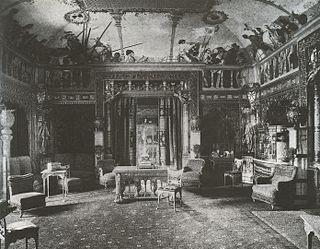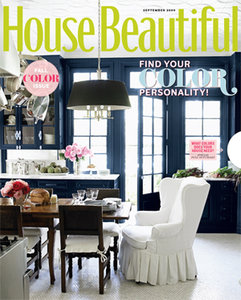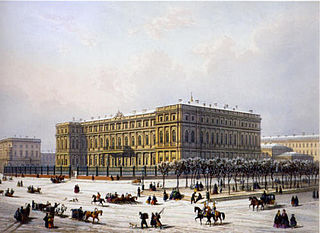Related Research Articles

A house is a single-unit residential building. It may range in complexity from a rudimentary hut to a complex structure of wood, masonry, concrete or other material, outfitted with plumbing, electrical, and heating, ventilation, and air conditioning systems. Houses use a range of different roofing systems to keep precipitation such as rain from getting into the dwelling space. Houses may have doors or locks to secure the dwelling space and protect its inhabitants and contents from burglars or other trespassers. Most conventional modern houses in Western cultures will contain one or more bedrooms and bathrooms, a kitchen or cooking area, and a living room. A house may have a separate dining room, or the eating area may be integrated into another room. Some large houses in North America have a recreation room. In traditional agriculture-oriented societies, domestic animals such as chickens or larger livestock may share part of the house with humans.

The Eastlake movement was a nineteenth-century architectural and household design reform movement started by British architect and writer Charles Eastlake (1836–1906). The movement is generally considered part of the late Victorian period in terms of broad antique furniture designations. In architecture the Eastlake style or Eastlake architecture is part of the Queen Anne style of Victorian architecture.

Interior design is the art and science of enhancing the interior of a building to achieve a healthier and more aesthetically pleasing environment for the people using the space. An interior designer is someone who plans, researches, coordinates, and manages such enhancement projects. Interior design is a multifaceted profession that includes conceptual development, space planning, site inspections, programming, research, communicating with the stakeholders of a project, construction management, and execution of the design.

The Wallace Collection is a museum in London occupying Hertford House in Manchester Square, the former townhouse of the Seymour family, Marquesses of Hertford. It is named after Sir Richard Wallace, who built the extensive collection, along with the Marquesses of Hertford, in the 18th and 19th centuries. The collection features fine and decorative arts from the 15th to the 19th centuries with important holdings of French 18th-century paintings, furniture, arms and armour, porcelain and Old Master paintings arranged into 25 galleries. It is open to the public and entry is free.

In architecture and building engineering, a floor plan is a technical drawing to scale, showing a view from above, of the relationships between rooms, spaces, traffic patterns, and other physical features at one level of a structure.

A cassone or marriage chest is a rich and showy Italian type of chest, which may be inlaid or carved, prepared with gesso ground then painted and gilded. Pastiglia was decoration in low relief carved or moulded in gesso, and was very widely used. The cassone was one of the trophy furnishings of rich merchants and aristocrats in Italian culture, from the Late Middle Ages onward. The cassone was the most important piece of furniture of that time. It was given to a bride and placed in the bridal suite. It would be given to the bride during the wedding, and it was the bride's parents' contribution to the wedding.

In Western architecture, a living room, also called a lounge room, lounge, sitting room, or drawing room, is a room for relaxing and socializing in a residential house or apartment. Such a room is sometimes called a front room when it is near the main entrance at the front of the house. In large, formal homes, a sitting room is often a small private living area adjacent to a bedroom, such as the Queens' Sitting Room and the Lincoln Sitting Room of the White House.

The firm of Herter Brothers,, was founded by German immigrants Gustave (1830–1898) and Christian Herter (1839–1883) in New York City. It began as a furniture and upholstery shop/warehouse, but after the Civil War became one of the first American firms to provide complete interior decoration services. With their own design office and cabinet-making and upholstery workshops, Herter Brothers could provide every aspect of interior furnishing—including decorative paneling, mantels, wall and ceiling decoration, patterned floors, carpets and draperies.

A billiard room is a recreation room, such as in a house or recreation center, with a billiards, pool or snooker table.

House Beautiful is an interior decorating magazine that focuses on decorating and the domestic arts. First published in 1896, it is currently published by the Hearst Corporation, who began publishing it in 1934. It is the oldest still-published magazine in what is known as the "shelter magazine" genre.

Renaissance Revival architecture is a group of 19th century architectural revival styles which were neither Greek Revival nor Gothic Revival but which instead drew inspiration from a wide range of classicizing Italian modes. Under the broad designation Renaissance architecture nineteenth-century architects and critics went beyond the architectural style which began in Florence and Central Italy in the early 15th century as an expression of Renaissance humanism; they also included styles that can be identified as Mannerist or Baroque. Self-applied style designations were rife in the mid- and later nineteenth century: "Neo-Renaissance" might be applied by contemporaries to structures that others called "Italianate", or when many French Baroque features are present.

Nicholas Palace is one of several St Petersburg palaces designed by Andreas Stackensneider (1802–65) for the children of Nicholas I of Russia. The palace of Grand Duke Nikolai Nikolaievich of Russia forms part of a sprawling complex incorporating a palatial church, a manege, and several outbuildings separated from Labour Square by a cast-iron fence.

The fireplace mantel or mantelpiece, also known as a chimneypiece, originated in medieval times as a hood that projected over a fire grate to catch the smoke. The term has evolved to include the decorative framework around the fireplace, and can include elaborate designs extending to the ceiling. Mantelpiece is now the general term for the jambs, mantel shelf, and external accessories of a fireplace. For many centuries, the chimneypiece was the most ornamental and most artistic feature of a room, but as fireplaces have become smaller, and modern methods of heating have been introduced, its artistic as well as its practical significance has lessened.

Victorian decorative arts refers to the style of decorative arts during the Victorian era. Victorian design is widely viewed as having indulged in a grand excess of ornament. The Victorian era is known for its interpretation and eclectic revival of historic styles mixed with the introduction of Asian and Middle Eastern influences in furniture, fittings, and interior decoration. The Arts and Crafts movement, the aesthetic movement, Anglo-Japanese style, and Art Nouveau style have their beginnings in the late Victorian era and gothic period.

Daniel Pabst was a German-born American cabinetmaker of the Victorian Era. He is credited with some of the most extraordinary custom interiors and hand-crafted furniture in the United States. Sometimes working in collaboration with architect Frank Furness (1839–1912), he made pieces in the Renaissance Revival, Neo-Grec, Modern Gothic, and Colonial Revival styles. Examples of his work are in the collections of the Metropolitan Museum of Art, the Philadelphia Museum of Art, the Art Institute of Chicago, and the Victoria and Albert Museum in London.

A klismos or klismos chair is a type of ancient Greek chair, with curved backrest and tapering, outcurved legs.
Italian Renaissance interior design refers to interior decorations, furnishing and the decorative arts in Italy during the Italian Renaissance period.
Mary Douglas Drysdale is an American interior designer who established Drysdale Design Associates in 1980. She specializes in commercial and residential interior design and incorporates the work of contemporary artists into her designs. The company operates from Washington, D.C. Drysdale has designed projects both in the United States and overseas. Drysdale frequently.

Eliza Warren née Jervis (1810–1900) was an English writer on needlework and household management, and editor of the Ladies' Treasury magazine. She was best-known professionally by the pen-name Mrs. Warren, but after a second marriage was also known as Eliza Francis and Eliza Warren Francis.

Charles Latham was staff photographer of the magazine Country Life in the early years of the 20th century. He is noted for his photographs of country houses and gardens, mostly in Britain and Italy.
References
- ↑ Greig, H. ‘Eighteenth-Century English Interiors in Image and Text’ Imagined Interiors: Representing the Domestic Interior Since the Renaissance. 2006 p. 102
- 1 2 Aynsley, J, 2005. ‘Graphic Change – Design Change: Magazines for the Domestic Interior, 1890–1930’ Journal of Design History. Vol. 18 No. 1
- ↑ Aynsley, J. ‘Displaying Designs for the Domestic Interior in Europe and America 1850–1950’. Imagined Interiors: Representing the Domestic Interior Since the Renaissance. 2006 p. 190
- ↑ Lees-Maffei, G 2001. ‘From Service to Self Service. Advice literature as Design Discourse, 1920–1970’. Journal of Design History Vol. 14 No. 3.
- ↑ Hamlett, J. ‘Managing and Making the Home: domestic advice books’ Imagined Interiors: Representing the Domestic Interior Since the Renaissance. 2006 p. 184
- ↑ McKay, H. ‘Designing Lifestyles: retail catalogues.’ Imagined Interiors: Representing the Domestic Interior Since the Renaissance. 2006 p. 242
- ↑ Lapostat, S. 2004–2009. Interior Design Magazines. Viewed 27 October 2011. http://decoration.com/reference/interior-design-magazines/index.html
- ↑ Magazines (UK) Id-Sphere. Viewed 27 October 2011 http://www.id-sphere.com/blog-info/magazines-uk/